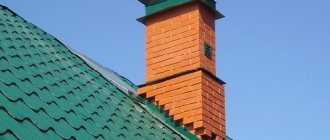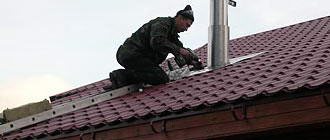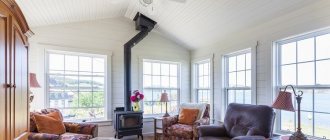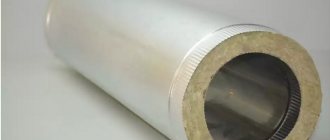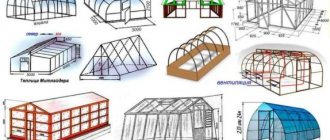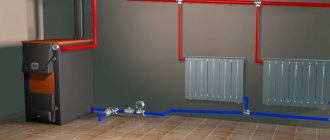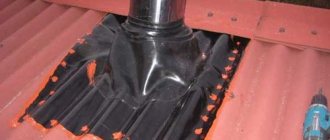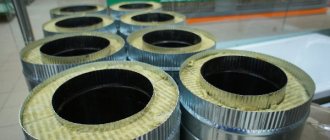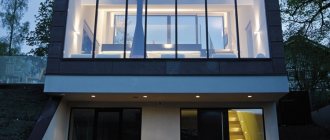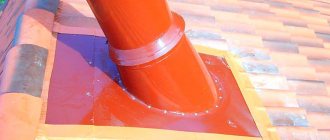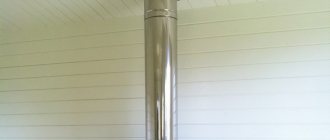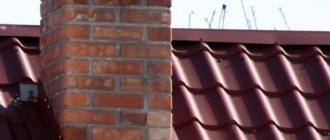A chimney in a private house or bathhouse is necessary if there is a fireplace, heating boiler or stove inside. It is responsible for removing fuel combustion products from the house. And if the question of constructing a stove falls entirely on the shoulders of the stove builder, then the task of correctly guiding the pipe through the roofing pie falls on the shoulders of the builders. The fact is that the chimney in any case violates the integrity of the coating - if the work is carried out incorrectly, then leaks and heat loss cannot be avoided. Let's look at how to properly pass a chimney through a roof made of metal tiles - one of the most popular materials for roofing.
Chimney passage through a metal roof
Arrangement of a square exit
A square or rectangular passage is installed for a classic brick pipe.
A hole in the metal tile is cut using metal scissors or a jigsaw. The second step in creating a passage for a square pipe is to install an internal metal protective apron. Work begins by marking the place where the pipe will be cut under the connecting strips of the internal apron.
The groove is made 15 mm deep. For better adhesion of the junction strips to the pipe, the groove should be sloping upward. The groove is cleaned with a stream of water to remove sand and dust.
The planks are installed as follows:
the upper, curved edge of each of the 4 planks is inserted into the hole made; The order of installation of the abutment strips is as follows: the bottom one is installed first, then the side ones, the top one is attached last; it is important to ensure sufficient overlap of the planks, about 15 cm, observing the sequence from bottom to top; The lower edge of the planks is secured with self-tapping screws to the roof sheathing.
A moisture-wicking tie is slipped under the bottom bar. This is a special iron sheet with curved edges. It is installed under metal tiles with an outlet to the edge of the roof or into the valley.
The waterproofing material is laid on top of the junction strips, with an overlap of 5 cm. After this, the metal tiles are laid in place.
The final stage of the square pipe passage is the installation of an external decorative apron. In most cases, such an assembled apron can be purchased ready-made, matching the color of the roof.
Self-tapping screws are used with special protective caps. All joints must be coated with silicone sealant.
Chimney passage options
For high-quality organization of smoke removal, when the load of atmospheric factors on the pipe and the place where it passes through the roof is minimal, it is important to correctly determine the location of the through hole for the pipe. The optimal solution, from the point of view of protection from rain and snow, would be to pass the pipe through a gable roof made of metal tiles through the ridge. However, such a conclusion implies a violation of the integrity of the ridge beam and the installation of additional supports, which is undesirable.
When determining the location of the chimney, the following considerations are used:
- a straight chimney draws better than one with several bends or a long horizontally oriented section;
- the pipe should not go out near the attic windows or onto the windows of a nearby building, since combustion products will be blown into them by the wind;
- in the valleys (the junction of two slopes on a complex roof) the maximum amount of snow accumulates; through holes are not made in the roof here;
- The closer the pipe is to the ridge, the less condensate will form in it.
For a gable roof, there are the following standards for the dependence of the height of the pipe on its location relative to the ridge:
- for a zone 1.5 meters from the ridge, a height of 50 cm is sufficient;
- for a zone from 1.5 to 3 meters, the end of the pipe coincides with the height of the roof;
- beyond the 3-meter zone, the height of the chimney can be lower than the ridge, but no more than an angle of 10 degrees between the highest points.
In a residential building, steam and waterproofing are installed under a metal tile roof, which also serves as a noise absorber, eliminating one of the main disadvantages of such a roof. It is very important to protect the junction of the roof and the pipe from leaks and cold air.
To protect flammable roof elements from the high temperature of the chimney, a special passage unit is installed to seal the penetration tightly. It is a box that is built into a through passage. The pipe itself is routed through the center of this box. On the outer and inner sides of the roof, the box is decorated with protective aprons.
Note! The distance from the wall of the brick pipe to the roofing pie cannot be less than 13 cm. If the pipe is ceramic, then this distance increases to 25 cm (SNiP 41-01-2003).
The passage through the metal tile roof is determined by the shape of the chimney pipe. It can be round, square or rectangular.
How to organize a chimney on the roof - general diagram
Chimney passage through a wooden ceiling
When installing a pipe, we must not forget that it is a potential cause of fire. Therefore, for its manufacture, a three-layer system is selected, which provides high-quality insulation. That is, there must be a layer of insulation between the outer and inner pipes.
The construction of a modern roof involves the use of a variety of materials, because it consists not only of roofing material. We need lumber for the construction of the supporting structure, rafters and sheathing, insulation to provide thermal insulation, as well as hydro- and vapor barrier films, which are the obligatory layers of the roofing “pie”.
Among the listed materials there are some that are quite susceptible to fire. That is why proper organization of the chimney is the key to the protection and fire safety of the house.
Advice Considering the importance of ensuring the safety of living in the house, it is recommended to buy components and materials for organizing a chimney in special stores where you can check the available quality certificates.
The procedure for installing a chimney through a metal roof
Installation of a chimney from sandwich pipes through the roof
The biggest problems can arise when arranging the passage of pipes through an insulated roof. Because it consists of a certain number of layers of insulation, including roofing insulating material and roof lathing.
Watch the video: bypassing the chimney through a metal tile
The box, passing through the ceiling, must be reliably protected from contact with the furnace smoke exhaust pipe. This is achieved through the use of mineral wool, which is based on basalt or fiberglass.
The assembly of the building being constructed for the passage of the chimney comes in various shapes. It depends on the type of material used in the construction of the passage through the ceiling. As a rule, the shape of the chimney on the roof is of the following types:
- rectangular;
- square;
- round.
The first and second types are created during the construction of a building made of bricks and blocks. And through the use of metal products and cement, they create a passage for the chimney, which has a round shape.
Basic requirements and standards
The quality requirements for metal tiles are regulated by GOST R 58153-2018. It became mandatory for all domestic manufacturers from March 1, 2021. The standard defines:
- minimum thickness of bare steel sheet for metal tiles and accessory passages;
- the amount of coverage on both sides;
- amount of zinc per square meter of finished product;
- profile shape, linear dimensions, crescent, oblique.
Thus, the thickness of the sheet, excluding the polymer coating, must be at least 0.5 mm. The recommended thickness of paint with primer is 23 microns or more. The norms, rules and all technology for carrying out work on the construction of a passage are described in SNiP II-26-76.
Where should not a chimney be placed?
A bad option is to place the chimney passage next to the attic windows. Remains of combustion products can be drawn into the premises by the wind and forced ventilation when the doors are open. It is extremely undesirable to make a passage in the area of the valley - the junction of two adjacent slopes. The reasons are as follows:
- This place experiences the greatest load of snow in winter.
- Problems with tightness are likely due to the greatest accumulation of water from precipitation here.
How to properly install a chimney
Ventilation outlet for metal tiles, what are these elements for, and how to install them
Before bringing the pipe through the metal roof, experts determine the location of the future chimney. When searching for the location of the pipe on the roof, they are guided by the following established rules:
- The chimney unit in a metal tile structure needs to be completely connected to the roof deck. Sealing the pipe is a prerequisite for correct and successful installation.
- On the surface of the area selected on the metal roof for the chimney pipe exit, snow and other precipitation should not accumulate in significant quantities. Additional water pressure on the roof can compromise the integrity of the deck. In addition, excess moisture can cause leakage into the living areas of the house.
- A chimney through a metal tile roof is not installed next to the attic windows. When there are strong gusts of wind, it can be difficult to avoid carbon monoxide and smoke from blowing back into the building.
All these requirements, as practice shows, are met by the area on the metal tile roof located near or at the very ridge of the roof. A warm zone, free from condensate accumulation, is used for installing the chimney stove pipe. Installing the longest hood, in turn, reduces the negative impact of external atmospheric factors.
If the roof of the building is flat or the ridge ridge rises to a distance of less than one and a half meters, the brick pipe exceeds the level by 50 cm. A ridge reaching up to three meters requires installation at the same level as it. If the distance to the ridge is significant, exceeding the three-meter mark, experts draw a conditional line to the horizon at an angle of 10 degrees, determining the lifting point for installing the pipe. To construct a hood you need lumber, bricks, insulation materials, and waterproofing films.
The mouth of the chimney is covered with a special umbrella made of roofing material to prevent moisture from precipitation. The chimney connected directly to the boiler room is not covered, as this may impede the exhaust of gases.
Square roof access
Let's figure out how to make an exit for a chimney that has a square shape. After the pipe is brought to the roof, it is necessary to complete the structure. The main seal, which ensures adherence to the metal tile covering, takes the form of a special apron mounted on the roof slope using metal corners. The installation of this part begins from the bottom wall of the exhaust system; the strips are attached with an overlap of 10-15 cm, filling the elements with a sealing compound.
A metal plane is placed underneath, along which water flows either into the valley or to the very end of the eaves strip. A metal tie is made with bends at the edges.
The metal tiles are mounted on top of the internal apron, then they begin to construct a decorative finish called an external apron, the part consists of abutment strips. The tightness is ensured by a self-expanding insulating film. To prevent cracking, specialists wrap the brick with a sheet of iron coated with a polymer composition.
Arrangement of a round exit
The main thing in installing a pipe with a round cross-section is the use of an additional element - a penetration for the roof. It is a sheet of metal on which a rubber or silicone cap is attached.
The use of modern technologies has made it possible to obtain a universal part that can reliably serve under extraordinary temperature conditions. Certain types of materials can withstand temperatures up to - 70 and + 275 degrees Celsius.
The round pipe passes through a cap on the penetration, which is tightened by selecting the desired part, with the hole of the ring 20% narrower than the cross-section of the chimney pipe. The apron is then secured to the roof structure.
Where to place the chimney
In fact, it will not be possible to simply install a chimney wherever necessary. Typically, this part of the stove structure or heating boiler is installed on the slope of the attic or on the ridge of the roof. The complexity of installing a chimney in the first case will depend on the type of attic - with closed or free access - as well as on the presence of a number of complicating factors (the same accessibility of work). If the pipe is mounted on a ridge or on a slope, where there is free access to the under-roof space, then the rafter system remains accessible. If it is quite difficult to get to it and the rest of the roofing elements, then you will have to dismantle part of the roofing pie, that is, dismantle the covering itself, the waterproofing, and the sheathing. Otherwise, it will not be possible to properly equip the passage area.
Chimney passage through the roof
On a note! The chimney channel is conducted through the roof by the upper part of the entire pipe - the so-called acceleration section, where a draft is created that removes the smoke outside. The pipe should not have bends or turns. So it is important to choose a place where you can really violate the integrity of the roof, without neglecting the stated condition.
Sectional diagram of a brick chimney
The ideal location for the chimney is between two adjacent rafters in an area where there are no tie rods or crossbars, at some distance from the ridge. Moreover, it is important that the pipe does not run too low along the slope and not too high, otherwise the work will be much more difficult - you will have to either interfere with the ridge units or tinker with the roofing. But it is best to place the chimney in the direction closer to the ridge, and not to the eaves of the roof.
How to choose a place for a chimney?
Table. The height of the pipe depends on the distance to the ridge.
| Chimney height | Distance from pipe to ridge, m |
| 500 mm above the ridge part | Up to 1.5 |
| On the same level as the ridge part | 1,5-3 |
| The height can be determined by a line drawn from the ridge to the horizon at an angle of 10 degrees | More than 3 |
The height of the chimney pipe above the roof is determined by its distance from the roof ridge
What should be the height of the chimney
Attention! The chimney should not be installed in the valley area or next to dormer windows. In the first case, it will not be possible to achieve the proper level of roof tightness. Also, in the valley area, the roof usually experiences the maximum level of snow load, which means that the strength of this unit cannot be reduced. In the second case, there is a risk of smoke or carbon monoxide entering the room.
All other standards regarding the installation of a chimney can be found in special regulatory documents. As a rule, the place where this element will pass is chosen at the design stage of the house. But in a number of cases - for example, during a major roof repair or replacement of a room heating source - the chimney is installed in a ready-made structure.
The height of the chimney pipe above the roof ridge
Chimney passage with a square or rectangular cross-section
In order for the passage of a chimney with a square cross-section to be as airtight as possible, it is necessary to make external and internal aprons (thin sheet metal is often used for this). Usually, the internal one is installed first, and then the external one, installed directly on the surface of the roofing pie. When creating a lower apron, markings are made on a brick pipe that correspond to the location of all the parts of the apron. Then the groove is made along the intended lines - the groove is done with a grinder to a depth of at least 1.5 cm. It needs to be cleaned of dust and dried.
Roofing apron made of steel with polymer coating
Next, all the apron strips are mounted, with their edges inserted into the groove made and secured with sealant. Fixation to the pipe itself is carried out using roofing screws
If there is a need for joining somewhere, then it is important to remember that the overlap of individual elements on each other should be approximately 15 cm - only in this case will it be possible to achieve the recommended level of tightness. A special tie is mounted at the bottom of the apron to drain water
It is directed towards the valley or cornice.
Diagram of the connection between the chimney and the roof
Afterwards you can move on to arranging the outer apron. It must be remembered that at this moment the metal tiles should already be laid on the roof. The parts of this apron no longer have to be inserted into the groove - just screw it to the pipe itself with roofing screws
It is important to ensure a good connection between the apron and metal tiles and not forget about waterproofing. By the way, the waterproofing coating should be placed on the chimney by about 5 cm
You can secure it with construction tape.
Selecting an output location
Choosing a convenient place to make a hole in the roof from corrugated sheets for the chimney pipe is half the success. Naturally, the decisive factor in this matter is the location of the stove. Professional stove makers recommend positioning the chimney strictly vertically, but there are more subtle nuances:
Scheme of the chimney outlet through the corrugated roof
- It is best to place the hole for the chimney outlet at the highest point of the roof, that is, closer to the ridge. The optimal distance from the ridge to the pipe is 50-80 cm.
- It is advisable that the hole in the corrugated roof for the pipe does not fall on the elements of the rafter system. To bypass them, use bends and corner sections of the chimney. Using them, you can set the rotation to 90 or 45 degrees.
- The length of the chimney pipe segments is calculated so that the joints are located above or below the places where the ceilings and corrugated roofing pass. Otherwise, making a quality connection will be problematic.
- To ensure good traction, the system should be 1-1.5 larger than the roof ridge. If the pipe is too high, the flow of smoke will have time to cool while passing through it, which leads to the appearance of condensation.
To check whether you have correctly identified the exit location of the future chimney, draw a mark on the corrugated roof with a marker and check its temperature at the end of the day - the pipe should be located in the “cold zone”, that is, remain in the shade for almost the entire day.
Preparatory stage of work
To avoid any difficulties during the pipe installation process, you need to prepare the work site and tools in advance. A hole from corrugated sheeting is cut according to the following technology:
After determining the configuration of the chimney, they plan where the exit to the roof will be located. Let us remind you that it is better to place the pipe vertically. The cross-sectional size of the chimney pipes is selected based on the recommendations of the heating device manufacturer. The thicker and higher the pipe, the better smoke removal from the stove
It is important that all segments are of the same cross-section and fit each other, and are inserted without creating a gap. On a corrugated roof, mark the outline of the pipe using a permanent marker. Using a grinder with a thin metal cutter, cut out a hole, moving a couple of centimeters inward from the intended line. You should work with corrugated sheeting carefully and slowly so that the edge of the cut is smooth, without jagged edges that could cause injury during the pipe removal process. You need to make short cuts in the corners of the hole to bend the edges of the corrugated board upward. They cut out the same thing in the ceiling, weigh it
A metal box is installed that will connect the pipe to the rafters. The chimney will pass through the hole inside the box; the distance between their walls should be at least 15 cm.
The insulation, waterproofing film, and vapor barrier membrane are removed from the hole made in the roof. It is necessary that the hole goes through.
Exiting the chimney pipe to the roof
All the preparatory work has been done, all that remains is to correctly connect the pipe and put the chimney into operation. To bring the chimney to the roof you need to:
Diagram of pipe insertion on a corrugated roof
- Insert a chimney pipe through the hole in the box and direct it to the roof. Using adhesive tape, the edges of the waterproofing film and vapor barrier membrane are securely fixed to the surface of the chimney.
- Fill the box tightly with expanded clay or lay mineral wool. These types of insulation are not subject to fire, so they thermally insulate the pipe and protect against sudden ignition of the wooden elements of the rafter system and sheathing.
- Place a rubber or silicone seal on the pipe, which protects against moisture seepage at the outlet. To ensure better waterproofing, the seal is glued to the corrugated sheet with a fire-resistant sealant.
- Install the chimney with new segments to the required height, tightening the joints with galvanized steel clamps.
- After this, all that remains is to make it beautiful - install an outer apron to match the color of the metal tile, which covers the rubber seal and the box.
Installing a decorative external apron
Do not be afraid of overheating of the waterproofing film from the surface of the chimney; it is reliably protected from fire by mineral wool or expanded clay placed in the box.
Even a novice craftsman can carry out the installation of a chimney pipe on the roof; the main thing is not to forget that a negligent attitude to this issue can lead to a fire and loss of your property.
Junction location
The SNiP standards relating to the installation of chimneys do not clearly regulate the location of the chimney pipe.
Only the parameters for determining the height of the chimney are specifically indicated:
- the chimney should rise above the ridge by at least 50 cm, if the pipe itself is located at a distance of up to 150 cm from it;
- if the chimney is located at a distance of 150-300 cm from the ridge, then its height can be equal to or higher than the level of the ridge;
- if the chimney is located more than 300 cm from the ridge, then the pipe on the chimney is placed level with the ridge or not lower than a line drawn from the ridge at an angle of 10 degrees relative to the horizon.
Condensation may fall inside the pipe or on the inside surface of the protective umbrella. The main danger of the resulting moisture is that at subzero temperatures it forms ice, which negatively affects traction. In addition, condensate flows down into the walls of the chimney, thereby promoting the development of corrosion processes and reducing the service life of the chimney.
It is better to route the chimney through the roof as close to the ridge as possible. There are two reasons for this:
- in this place it is much easier to organize the connection of the pipe to the roof;
- Due to the small area of the slope above the pipe, the formation of snow pockets, which lead to leaks, is minimized.
Features of repair work
It is easier to repair roof junctions with roof structural elements using the flashing method, the technology of which is described above.
The basis of this method is the one-component mastic Hyperdesmo - RV-1K, consisting of bitumen-polyurethane substances. Its advantage is that it can be applied to any surface of a wide variety of shapes, creating reliable waterproofing everywhere that will serve for many years. In addition, the mastic is easy to apply and does not require special knowledge or equipment. There is no need to light an open fire on the roof, exposing both the roof itself and the workers to the risk of fire.
Repairing joints to various roof structures using traditional roll materials and hot bitumen is much more expensive than using mastic. You can also repair the roof at its junction points in another way.
If the roofing material has just peeled off from the wall, but is still in good condition, it is pressed with a strip, which is fixed with self-tapping screws. The junction of the slats and the wall is sealed with Emfimastica PU-25 polyurethane sealant.
Strengthening the rafter system
Often when installing a chimney, the question arises about strengthening and strengthening the rafter system, because it is necessary to form a hole in the roof pie for the pipe. That is, you will need to install a couple of spacers. When creating a roof made of metal tiles, the pitch between the rafters is rare, and the formed opening or the distance between the rafters may be too large. Therefore, it is necessary to install vertical spacers.
Pipe outlet box arrangement
Sometimes you have to break the integrity of the rafter leg, that is, cut it. Then, in certain situations, purlins or crossbars are also sawn. In this case, at the place where the rafter leg was cut, it must be fastened to adjacent, undamaged ones. For this, additional spacers are also used, between which bars are inserted vertically. Their function is to replace the rafter leg at the chimney passage.
Let's sum it up
Now you know how the chimney passage unit is designed and how to install it on a metal tile. This means you can make the roof of your house more airtight and fireproof. If you have any questions about the method of installing pass-through elements, write about it in your comments.
Did you like the article? Subscribe to our Yandex.Zen channel
October 26, 2021
Chimneys, Roofing works, Roofing, Operations with chimneys, Operations with pipes, Chimney laying, Pipes
If you want to express gratitude, add a clarification or objection, or ask the author something, add a comment or say thank you!
How to route a pipe through a metal roof
It is worth thinking about venting the pipe through the roof at the stage of installing a fireplace or stove. The chimney must be safe, efficient and, preferably, aesthetically pleasing. Reliable waterproofing and correct selection of the outlet location are the key to long service life of heating equipment.
The technology for installing the pipe depends on the roofing material. How should the passage through metal tiles be organized? To prevent leaks from occurring, the chimney to become dirty less often, and fire hazards to avoid occurring, the installation process is carried out using strict technology.
Where should the chimney be installed on the roof?
The area where the pipe meets the roof is a potential leak point. The design of the roof opening must meet 2 requirements:
To solve these problems, special building materials are used.
From the point of view of opening design, the ideal choice of location is the ridge of the roof. There are no snow pockets formed here and the likelihood of condensation inside the pipe is reduced. Located mostly in a warm zone, it will always be warm.
Also, if the pipe is positioned “through the ridge”, it is easy to bypass it with metal tiles. The disadvantage of such a passage is the need to create a ridge rafter system “with a gap.” And these are additional supports that interfere with the operation of the attic space.
Often the heating device is not installed in the center of the building, so the optimal location for the chimney is near the roof top. In this case, the pipe will effectively cope with its functions.
You should not install the pipe in the following places:
In such places, it is extremely rare to avoid leaks due to the design difficulties of installation. You should not create a passage near the attic windows - smoke and combustion products will enter the room with gusts of wind.
How to remove a square pipe correctly?
The method of designing the passage greatly depends on the shape of the chimney. The pipe can have a round or square cross-section. In both cases, special training is carried out.
When installing a square or rectangular pipe, an apron is installed even before laying the main coating. Installation procedure:
- an internal connection strip is applied to the pipe wall and a mark is placed on the position of its upper edge;
- The chimney wall is grooved along the drawn line;
- The first to install the strip is from the side of the cornice;
- all strips are sealed with silicone;
- a tie is formed - a sheet of metal is placed under the lower part of the apron, and the outlet chute is directed towards the eaves overhang;
- The main covering is laid and the outer apron is installed.
For a round pipe there is its own installation technology. When performing this procedure, it is recommended to use special passage elements.
They are able to reliably isolate the roof opening. The element is made up of a metal base and an elastic cap equipped with transition diameters.
Round pipe installation procedure:
- to begin with, select a ring of the passage element, which is 20% smaller than the cross-section of the chimney;
- the element is trimmed at the selected level;
- a hole is cut in the roof that matches the diameter of the pipe;
- using liquid soap, the element is pulled onto the chimney;
- the base of the sealing element is given the shape of the roof (by pressing);
- Sealant is applied under its edges, and the element itself is screwed with self-tapping screws.
When scoring a brick pipe, you should make sure that the edge goes along the brick and not along the masonry seam.
Methods for sealing a pipe outlet
In addition to constructing an apron, several options are used to seal the chimney opening: creating a special box, installing an umbrella, using self-adhesive tapes.
The box is designed to separate the pipe from the roof and effectively remove moisture. It is created using rafters. The box is located 15 cm from the chimney.
It should be filled with special stone wool. With such material, there is no need for vapor and waterproofing. In this case, metal tiles are insulated in the traditional way - using film. The junction of the box and the film is fixed with a sealant.
The installation of the umbrella is carried out when installing a metal chimney. The layout is made of cardboard. After determining the dimensions, the sheets are tightened on the pipe with a clamp. The gaps are sealed with sealant.
It is important to approach the installation of the pipe as responsibly as possible. This will protect the opening from leakage and prevent rotting of the rafter system.
Installation of a square and round chimney has its own characteristics. You can seal the pipe using a box, an umbrella, a transition element and special construction tapes.
Bypassing a chimney made of a brick pipe, installing an apron
To arrange the junction, two problems must be eliminated. The first is to transfer the water that flows from the slope, redirect it on both sides of the structure being built. After this, she is released onto the ramp under the building. The second is to prevent water from entering the home, and direct the liquid that flows down the walls of the chimney to the roof.
To solve all this, you should build an apron made of metal. It must stand on the surface of the roof and on the pipe (at a distance of 15 - 20 cm above the plane).
Before work begins, the chimney is plastered. After that, waterproofing protection is placed on its sides. From the rear side of the edge, no more than 80 cm, a gutter is built into the waterproofing to drain water.
Before asbestos or other chimney pipes are removed through a metal-covered chimney, a sheathing is installed and a lower apron is installed on it. For this task, the left and right sheets are cut along the contour and then cut to width. The length is maintained at 5 cm from the place where the first wave begins, which will pass from above the chimney in the house or in the bathhouse.
Watch the video: brick chimney - how to go through a metal tile roof
How to pass a roof with a brick pipe
Lines are drawn on the sides, which are located 15 cm above the surface part of the roof. Then they are connected along the entire length of the contour. Using this marking, grooves with a width of 2 mm are made.
The grooves need to be drawn along the brick, and not along the masonry. After treatment, the area is cleaned of contamination and thoroughly washed with water. When it dries, the grooves are filled with silicone-based sealant.
Afterwards, prepare the abutment strip and the necessary elements of the apron. Next, the outermost part of the strip is inserted into the sealant and attached to the metal tile using self-tapping screws.
Round and square chimney passage
The problem of how to correctly route the passage of a round pipe through a metal tile is becoming quite urgent. If the round pipe blank is already equipped with insulation, then the roofing cake must be protected from fire.
If, when installing through the ceiling, materials that are easily flammable are used, then they should be at a distance of no less than 20 cm from the chimney. In this case, a passage opening is made in the form of a wooden box. And the empty space is filled with thermal insulation material.
When equipping a passage channel for a round pipe blank, the following technological sequence is used:
- the waterproofing is cut in the shape of an envelope;
- the extreme parts of the canvas are brought to the rafters and fixed to the building, which plays a load-bearing role, with staples;
- then the waterproofing film is pressed against the bars included in the sheathing, and the vapor barrier layer is pressed against the base for installing the finishing material;
- in order to protect the insulating material as much as possible, the abutment zones are taped with a special tape;
- at the end, the surface where the work was done is covered with metal tiles.
How to pass a steel pipe blank through a roof
Actions with such a construction do not like to be rushed. The master who took up this task must clearly understand the features of each ceiling. For example, the passage of a brick structure through a wooden ceiling, as well as through any other, must be carried out without losing the integrity of the roof.
Otherwise, after the first rains the ceiling will leak. It is also important to take into account that the waterproofing of a steel chimney on a slate floor will not be the same as on a wooden floor and metal tiles.
How to make an exit for a pipe on a roof made of metal profiles / metal tiles
Single-layer steel pipe becomes very hot. Therefore, a ceiling opening where wood is used for construction must be equipped with a thermal insulation barrier or a special box. Thus, they work not only on wooden floors, but also on any other.
Performing a pass without fluffing
The brick chimney is designed to provide protection for combustible materials from overheating. The part of the structure that is carried through the ceiling covering becomes a cutting, and has the name “fluff”. This element plays the role of the necessary thickening of the pipe walls, which protects against overheating.
Recently, expanded clay or vermiculite have been used to pass a brick chimney structure through the ceiling without fluffing. These materials have good thermal insulation characteristics.
Plain sand is extremely rarely used for such a task. The whole problem is that the sand has too fine a fraction and a large mass. For such a “fluffing” function, the thermal conductivity of this material is too high.
An easier and simpler solution to this issue is to use a box filled with heat-resistant basalt wool. When installing mineral wool, the building from the attic side is equipped with free access to it.
In cases where the building is located on the second floor, the opening in the floor with insulation is covered with a sheet of metal.
Ventilation passage
Exiting ventilation to the roof is a prerequisite for construction. A fully equipped roof ventilation system is the key to long-term use of housing. Circulated warm air from inside the room causes condensation to appear on cold surfaces.
The conclusion from this is simple. Being under such influence, the erected structures quickly lose their integrity. For this reason, forced ventilation is installed.
It is not difficult to purchase ventilation of any type in hardware stores. It doesn’t take a lot of time and effort to reach its conclusion. This installation is carried out in this way.
- The passage element is laid on a tile base and its outline is traced. This is how the place where it will take place is determined.
- The metal tiles are cut according to the applied markings.
- The rubber seal is fixed to the metal profile with self-tapping screws. Next, it is carefully treated with silicone.
- The passage part of the ventilation duct is fastened with a rubber seal and attached to the roof with screws.
How to install asbestos and sandwich chimneys
In many situations, connecting a sandwich pipe to the roof through a metal tile becomes an excellent alternative to a brick chimney for a stove. This type of construction is easy to install. Since the main elements are two pipes of different diameters, between which a thermal insulation layer of basalt wool is placed.
Making a passage for a sandwich building on a metal roof can be done even by a person who does not have much construction experience.
And the ease of installation in this case is complemented by excellent performance and a long service life.
Experts say that for removing flammable substances, there is a better option than a sandwich - a pipe is difficult to find. After all, such material is excellently protected from strong overheating of the walls from the outside. The same applies to the formation of condensation.
To these advantages it must be added that this building looks very presentable.
To sum it up briefly, we can come to a conclusion. This entire process does not contain any highly complex actions. The main thing when working step by step is to comply with the requirements established by SNIP, maintain all dimensions and follow the recommendations.
If everything is done according to the rules, then the operation of the heating device will become absolutely safe, and there will be no problems with the inspection authorities.
How to choose a cut
There are two types of roof trims - for chimneys with a round and rectangular cross-section. In the latter case, the sealed apron is assembled manually from roofing iron. Despite the complexity, this option is considered the most reliable. Cuttings for a round pipe are made at the factory; they look like a corrugated cuff with a wide brim. For a high-quality and hermetically sealed connection, the pipe passage must be insulated with two aprons: an internal and an external decorative one.
To pass round pipes through metal tiles, flexible grooves made of heat-resistant synthetic rubber are used. A more exotic option, mainly made in Europe, is composite aluminum trims. In both cases, the essence of their work is that they repeat the complex profile of the metal tile and are attached to it both mechanically and with a sealing adhesive connection.
Making cuts yourself requires a certain skill and a simple set of tools for roofing work - a mallet and a right-angle mandrel. Both the bottom and top aprons consist of four Z-shaped strips. At the corners, the planks are joined either with a hem or with folds, which is preferable. Cutting strips of roofing steel must be done without overheating the edges; in addition, the edges adjacent to the chimney and roof must have a fold, that is, single rolling.
Roof cutting of round pipes
To seal sandwich-type pipes made of stainless steel or round ceramic pipes, roof penetrations with a metal or polymer cap are used. In addition, to protect wooden structures from overheating, it is necessary to install a thermal insulating box made of non-combustible material at the place where the pipe passes through the roof, and fill the space between the walls of the box and the pipe with a non-flammable heat insulator. Stone or basalt wool is used as a heat insulator; their melting point is significantly higher than that of the chimney in operating mode.
Exiting the pipe to the roof and installing the cutting
Purchase or make your own pipe from thin-walled metal. Its dimensions must provide a fire-prevention distance from the pipe to flammable structures - at least 25 cm in any direction. The pipe has the form of a box with a lid, with holes on both sides equal to the diameter of the pipe. The pipe must be finished with fireproof insulation - the figure shows finishing with basalt wool with a heat-reflecting layer. You can secure it using heat-resistant sealant and metallized tape.
Pipe for passage through ceilings
Mark the place where the pipe passes through the ceilings and cut a hole in it to the size of the pipe using a jigsaw to cover the entire thickness of the heat-insulating “pie”. Install the pipe.
Hole in the ceiling for the pipe
The chimney is removed from sandwich-type pipes through a hole in the pipe, the gaps are treated with heat-resistant sealant with an operating temperature of up to 1000 degrees. Insulation – basalt wool – is placed between the walls of the box and the pipe. The passage is closed from below and above with lids and secured with self-tapping screws.
Installation of pipes in ceilings
Mark the place where the pipe passes through the roof and cut it out in the same way. In this case, the hole will not have a square, but a rectangular shape due to the slope of the roof. Install the lower cutting apron. It is chosen depending on the slope of the roof - the steeper the slope, the more elongated the hole will be.
Hole for pipe exit to roof
Continue installing the pipe through the cut hole; the apron can be temporarily lowered down. The pipe must be tightened with clamps and secured to the roof structural elements with brackets.
Pipe outlet to the roof
Bring the pipe to the roof to the required height
In this case, it is important to follow the rule: the connection of the elements should not be located in the place of passage through the roof or ceiling; if the dimensions of the pipe do not allow it to be made, it is necessary to trim one or more elements. It is better to install clamps securing the pipe at the joints, and seal the joints - this ensures maximum stability of the pipe and fire safety
Roof pipe installation
After the pipe is installed and brought out, the lower apron is secured, and the roof groove of the selected type is put on the pipe. The figure shows a roof section with a metal apron laid on top of the roofing covering - corrugated sheeting. The upper edge of the apron is placed under the overlying sheet of corrugated sheet, and its side parts are cut so that they are in the upper part of the wave of the metal sheet. With such a design and a large roof slope, water will not flow under the apron.
Installation of apron and cutting
For other types of roofing, roof sections of a different type can be used, for example, metal-polymer or with a lead apron.
Different types of roof grooves for round pipes
When using a flexible cutting made of silicone or rubber, a hole is cut in the cap 1/5 smaller than its diameter. The cap is pulled over the pipe and the flexible apron is given the shape of a sheet. They are secured with self-tapping screws, having previously been coated with sealant. For a more durable fastening, it is sometimes necessary to strengthen the roof sheathing - this is done at the stage of cutting out a hole in it.
Installation of silicone groove
A flexible lead apron can also be bent to the shape of a roofing sheet, but when purchasing it, you should take into account the angle of inclination of the slope. The upper edge of the apron must be placed under the overlying sheet of slate or metal.
Cutting with flexible lead apron
External apron system at the junction area
Experts highlight the connection of the chimney to the metal tile as a very important factor. To ensure the tightness necessary in this situation, an apron is built outside. Installation work begins with the installation of the internal apron. In this case, they place a bar or steel sheet at the top and bottom and the same elements on the sides.
The bar at the bottom is applied to the walls and a line is drawn with a marker.
The remaining parts are also used as a template for subsequent marking. When the line around the perimeter is completed, they begin to make grooves. It is better to make them with a grinder, going deeper by 15 cm.
At the end, they are washed with water, the brick dust is washed off, and they wait until everything dries.
In order not to break the tightness when connecting the smoke exhaust structure to the metal tile floor, it is important to ensure that the grooves pass exactly where the brick is laid
When installing the outer apron of a smoke exhaust structure through a soft roof, heat-resistant waterproofing protection is used. It is inserted onto the pipe blank by 5 cm.
The cut itself is glued to the pipe product using construction tape. And the place where the pipe extends beyond the soft roof is wrapped with film. To securely adhere to a soft roof, it is recommended to use Ecobit.
The most optimal areas of the roof for organizing passages for the chimney pipe
Where is the best place to plan the pipe exit through the metal tile? Taking into account the specifics of installing the adjacent unit, it is best to place the opening on the roof ridge. This placement will protect the roof surface from such unpleasant phenomena as snow pockets. In addition, sealing a pipe on a metal roof in this case is much more reliable. It is important to remember that this installation method is associated with certain difficulties. For example, when creating a project, it is important to provide for the presence of a divided ridge beam, or its complete absence. In the first case, additional supports are installed under the rafters, leading to difficulties in operating the attic space.
How to pass a pipe through a metal tile in another way? This can be done not far from the roof ridge, along the slope. In this case, organizing the junction does not cause any difficulties, because snow pockets simply cannot form in this area. If a pipe is routed through a metal tile where the slopes intersect, then many difficulties will have to be overcome to make a quality connection. It is recommended to use other passage options, and this one should be considered only in exceptional cases.
Exiting the pipe through the ceiling should be done slowly, taking the necessary precautions. It is also important to prepare the necessary materials and tools in advance. Otherwise, the work may not only be performed poorly, but may result in damage to structural elements and ceilings. It is recommended that when carrying out such robots with your own hands, you strictly follow the instructions, then a good result is guaranteed.
The process of eliminating cracks in a corrugated roof
As a rule, when installing a chimney through a corrugated roof, a ready-made Master Flash pipe cutting is used. Another advantage is that this set is very convenient to use; it can be used for roofing made of almost any material.
In essence, Master Flash is an apron cap made of silicone or rubber, placed on an aluminum base.
As for operating temperatures, for the silicone version of products it is significantly wider - in the range from -50 to 130 ℃.
The process of sealing cracks on a profile roof includes the following manipulations:
- A gap is cut in the cap, the diameter of which is slightly smaller than the cross-section of the chimney.
- The Master Flush is put on the chimney.
- A gasket is placed at the base of the chimney.
- The joints between the material are sealed with silicone sealant.
- The base of the chimney is fixed to the profile roof using screws.
Often the described manipulations do not provide sufficient tightness on the profile roof, so that during rainfall water leaks into the cracks. In such cases, the best option is to use self-adhesive tape reinforced with aluminum. It is very convenient to use such material, since it does not require pre-heating before use.
Thus, the fact how well a corrugated roof will be sealed at the exit point of the chimney depends largely on the choice of material and the quality of the work performed. However, we are confident that by following our instructions exactly and working responsibly, you will be able to protect your home from any surprises associated with roof leaks.
Features of metal tiles as a roof
Metal tiles are roofing materials made from profiled steel sheets using the cold deformation method. To protect against the negative effects of precipitation and sun, the material is pre-galvanized. It is then coated with a protective polymer coating of various colors.
Externally, a roof made of metal tiles is similar to masonry made of ceramic elements. Profiled steel sheet is lighter than other roofing materials, cheaper both in cost and installation costs. If it is necessary to make a passage for a chimney, the material wins in terms of practicality, since it cuts well and is easily fixed with fasteners.
Advantages and disadvantages of coating
Advantages of metal tiles:
- service life up to 40–50 years;
- high strength with low weight;
- complete with additional standardized elements that give the roof a high-quality, complete look;
- operating temperature range – from -50 to +120 °C;
- Suitable for any roof with a slope angle of 14°;
- high resistance to aggressive environments;
- fire resistance;
- wide range of colors.
I note that with all the positive qualities, metal tiles also have some disadvantages. The main ones:
- A large amount of waste after roofing work - up to 5–40%.
- When it rains or hails, a metal tile roof makes noise if sound insulation is not done first.
- The likelihood of corrosion in places where the protective coating has been damaged as a result of cutting or damage with sharp objects.
- High thermal conductivity - a metal tile roof overheats in the sun.
Making an opening for the chimney
Fire safety requirements provide for an indentation from the chimney body to the elements of the rafter system and roof pie, made of combustible or subject to melting materials. The size of the gap is determined by the presence of non-combustible insulation in the chimney duct, the thermal conductivity of which does not exceed 0.3 m2*°C/W. Thus, for brick and ceramic wells the indentation should be at least 250 mm, while for a certified sandwich pipe 130 mm is sufficient.
Taking into account the dimensions of the chimney duct, determining the size of the opening is quite simple. Next comes the application of markings to the parts of the internal cladding and sheathing. Vapor barrier and waterproofing materials are cut into an envelope and wrapped inside the cake. Next, the internal surfaces of the opening should be finished with a waterproofing material that is not sensitive to heat; as a rule, aluminum or copper foil is used for this purpose.
Please note that by this time the metal tiles must be dismantled around the passage area. The best option is to dismantle starting from the ridge and remove one sheet in each direction from the opening
Thus, the passage in the roof must be completely free at the time of installation of the chimney pipe. For roofs under metal tiles, the following procedure is typical: first, the rafter system is prepared at the place where the pipe passes, then the roof pie is arranged according to the general scheme, after which the opening is filled and the covering is installed with cutting.
Recommendations for placement and decoration
It is not recommended to install the pipe near the attic windows, since the wind will blow combustion waste into the attic. It is best to install a chimney duct near the ridge, because even in snowy winters a little snow accumulates there, and the threat of leaks is minimal. The height of the pipe with this arrangement is the smallest, which significantly reduces the degree of climatic influence on its surface. This is especially true during cold periods, when condensation can accumulate inside the chimney.
If there is a ridge on the roof, then when organizing the passage of a pipe through a metal roof, the height of the chimney will depend on the distance to the ridge:
- A distance of up to 150 cm implies the need to install the chimney to a height of at least 50 cm above the ridge.
- When the distance to the ridge is 150-300 cm, the pipe is made flush with the ridge.
- If this parameter exceeds 300 cm, the height of the pipe is calculated by drawing a line at an angle of 10 degrees between the ridge section and the horizon.
Strengthening the rafter system
In the simplest case, the opening is limited by two spacers installed between the rafters. Thus, a square is formed in the roofing pie, the walls of which are spaced at a distance no less than the standard one. Light metal roofs are characterized by a sparse rafter pitch, so usually the horizontal dimension of the opening turns out to be excessively large. It can be shortened by inserting a couple more vertical struts between the horizontal struts. This is desirable not only from the point of view of reducing the gap in thermal insulation: even in a cold roof, an opening of the minimum permissible size will cause fewer difficulties with the installation of non-combustible sheathing and fastening the metal tiles in place.
In difficult cases, the rafter leg has to be cut. Depending on the height of the passage, a tightening, a crossbar, or several purlins are also dismantled. The general method of strengthening the rafter system is as follows: at the cut site, the rafter leg at the top and bottom is fastened to its neighbors by means of horizontal struts. Next, vertical beams are inserted between these spacers, replacing the rafter leg at the passage point. The same method can be applied to other elements of the supporting system located in parallel: purlins or, for example, high puffs.
Reinforcement with the help of supporting posts is rarely practiced. This is mainly advisable when the slope is above 35°, when it is necessary to cut out fairly long fragments of the rafter system. In such cases, the opening is equipped with its own supporting system, often of a hanging type. To ensure sufficient strength, it is customary to connect the opposite legs with ties on which the racks will rest.
How to arrange a pipe outlet
Let's consider how the pipe should be routed through the metal tile so that the risk of leaks at the junction areas is minimized.
Rectangular outlet
The organization of rectangular, in particular, and square output is carried out in two stages:
- installation of the internal apron before installation of the coating begins;
- installation of an external decorative and protective element after completion of the roof covering.
Schematically, installation of the output can be reduced to the sequential implementation of the following steps.
- Find out the location of the upper edge of the inner junction strip by attaching it to the chimney wall.
- Along the marked marking line, for example, using a grinder, make a groove with a depth of at least 150 mm. The groove should have a slight upward slope. At the end, it is cleaned well, it is advisable to even rinse it with water.
Attention It is imperative to inspect the rafter system, since due to a leak, the wood may begin to rot or fungus may form on it, but, say, the new roofing material will weigh quite a lot.
- The connection strip is first installed on the side of the chimney, on the eaves side, then the other three are mounted: on the sides and at the top.
- The planks are laid with an overlap of 150 mm and the edges are filled with silicone sealant. They are fixed using roofing screws.
- To form a “tie” through which water will flow, a metal sheet is placed under the bottom of the apron. It is directed either directly into the gutter or into the valley.
- Remove the waterproofing and, lifting it approximately 50 mm onto the chimney wall, secure it with special heat-resistant tape. This ensures additional reliability of the junction unit.
- After installing the coating, an external apron is installed, which is more necessary for decoration than protection.
- It is installed in the same way as the internal one, only the pipe walls are not tapped to secure the outer planks. In fact, the lower apron, bypassing the pipe with metal tiles, is sandwiched between its layers, preventing moisture from getting under the roof.
Round (oval) outlet
Providing reliable junction protection for a round exit is a more difficult task. Therefore, a special element was developed - the chimney passage. This is a combined element, which includes a flat steel base and an elastic cap on the chimney pipe. Transitional diameters are marked on it. The passage components are hermetically connected to each other.
Additionally, we recommend studying: The passage of a chimney through a wall.
The caps are made from EPDM rubber or silicone, which have increased heat resistance. Silicone can be used at temperatures from minus 75°C to plus 260°C, from EPDM - minus 55°C to plus 135°C. Thanks to their elasticity, the junction is reliably insulated. For greater effect, it is recommended to select a ring on the passage hood that is smaller than the cross-sectional diameter of the pipe by about 20%, and cut it at this level.
Advice Pass-through elements are also suitable for arranging any part of a circular cross-section that is exposed to the roof, say, ventilation.
The process of installing the passage is performed in the following order:
- It is necessary to cut a hole of the appropriate diameter on the roofing.
- After wetting the element with liquid soap, it is pulled onto the pipe.
- The sealing element is given the shape of a metal tile by pressing against the base.
- To fix the element, use self-tapping screws, after applying sealant under its edges. The screws are placed at a distance of 35 cm from each other.
Advice
If desired, you can make a passage element for metal tiles yourself. However, it must be taken into account that the roof cutting performed in this way must comply with all building codes and regulations
Chimney removal technology
Despite the fact that metal tiles are successfully used today on both ventilated and non-ventilated roofs, in order to correctly understand all the intricacies of installation, it is better to consider the most complex case of chimney outlet equipment. In this case, the chimney exits through an insulated roof with a layer of steam and waterproofing.
Arranging the passage of a steel pipe through a steel roof
Modern chimney designs today practically do not use simple thick-walled pipes. Steel pipes, to which thermal insulation is attached manually and secured with wire or metal ties from the outside, have been replaced by sandwich structures with fire-resistant insulation between the outer and inner metal parts.
Such pipes are much more efficient than simple steel pipes. They are lighter, they have standard fastenings and are easily connected to each other. In addition, the multi-layer insulation design does not allow condensation to form, which significantly extends the life of the chimney.
Installation of such a chimney is carried out in the following sequence:
- Markings are made at the intended installation point of the chimney pipe;
- A hole with a diameter of 4-6 mm is drilled, and the accuracy of the selected installation location is determined using a metal probe;
- If necessary, adjustments are made and the installation location is specified;
- Using a jigsaw or grinder, a hole is made in the metal tile that is 3-5 mm larger than the diameter of the pipe;
- The insulation layer is disassembled, a hole is carefully cut out in the waterproofing, it is made exactly according to the diameter of the pipe;
- A cut is made in the OSB layer of the board or sheathing boards;
- The next step is to install a silicone cap under the insulation with a cut hole that is 2-3 mm smaller than the pipe diameter;
- A metal pipe with a sandwich filler is being installed;
- The membrane is removed from under the metal covering so that it extends 1-2 mm out between the pipe and the tile;
- Using heat-resistant tape, the membrane is glued to the outer plane of the pipe;
- A silicone cap with a cut hole for the pipe is placed on top of the pipe (it is recommended to moisten the outer surface with liquid soap before this, this will improve the sliding of the silicone on the metal);
- Before you start fixing it on the metal tiles, it is fixed to all surfaces using silicone;
- Using a flexible metal rail and self-tapping screws, the cap is fixed to the profile.
When arranging a chimney pipe during construction work, it is recommended to calculate the material so that the chimney pipe is located at the junction of two profile sheets. This option makes it possible to better install all structural elements from the membrane around the pipe to the metal rim of the cap.
Passage of a brick pipe through a metal tile
Unlike a metal pipe, brickwork has a slightly different output equipment technology. Here the pipe must be erected before the construction of the truss structure begins. At the passage point, the rafters are fixed at a distance of 20-30 cm from the brickwork. To avoid fire, the pipe is wrapped in foiled basalt wool.
After installing the insulation on the rafters and covering it with a membrane, an internal apron from the kit for lining the roofing material is installed on the masonry. After this, a cut is made in the brickwork at a height of 100-150 mm above the level of the coating surface with a grinder along the entire perimeter to a depth of 100-150 mm. The surface of the masonry is treated with a water repellent.
Passage of a brick pipe through a metal tile
Attention: the groove must be as level as possible and at an angle, this is done so that the metal plate goes into the brickwork and the water flows down.
Next, the work algorithm is as follows:
- The junction strips are marked, cuts are made on them and the strips are bent to the size of the brick pipe;
- The bottom bar is installed first, then the side bars, and lastly the top bar. The installation is done in such a way that the bend extends as far into the masonry as possible;
- Before fixing the slats, the groove is filled with silicone;
- The planks are fixed with roofing screws;
- A metal screen is installed on top to drain water;
- Next, thermal insulation of the roof and waterproofing material are laid, which is fixed to the brick with silicone or liquid nails;
- Next, the covering is installed, while the lower and side parts of the contour should be above the metal tile, and the upper segment below it;
- After laying the metal tile sheet, the upper edge is installed. Its main task is to protect the brick from the influence of the snow cap and cover the joint between the brick and the metal.
Chimney apron for metal tiles
For lining rectangular structures, and even round and even oval standard sizes, manufacturers offer entire sets of elements that allow you to easily design a chimney.
As such additional parts, both solid elements and prefabricated elements consisting of several parts are used. Solid elements exactly repeat the profile of the chimney, so that the exiting pipe or masonry is tightly fixed in the hole. Prefabricated elements allow you to select elements and make a contour based on the individual dimensions of the chimney.
For round elements, it is most effective to use a metal apron with a silicone cap. This makes it possible to reliably seal the joint between the cap and the pipe by pressing soft silicone between two metal plates.
Bypassing the pipe with metal tiles
The easiest way to bypass a chimney pipe with metal tiles is to start roofing work from the pipe itself. Using several sheets of small metal tiles will help make the work easier. This option can be used when the pipe passes through one of the roof slopes. The roof around the chimney is arranged in small sheets, and the rest of the surface is covered with sheets of longer length.
Before cutting the sheets, it is recommended to make markings from sheets of cardboard, this will make it possible to ensure the accuracy of the cut and the tight fit of the metal to the brickwork.
It is recommended to proceed similarly with a round or oval pipe. Before placing a round pipe under the metal tile, it is worth calculating the waveform at the junction of the metal tile sheets in order to correctly fix the apron and cap.
